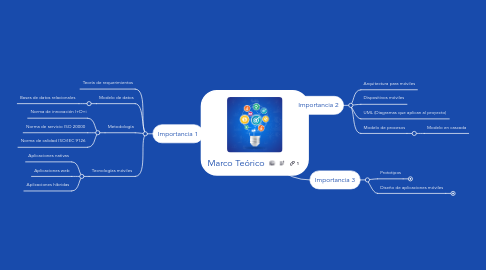
1. Importancia 1
1.1. Teoría de requerimientos
1.2. Modelo de datos
1.2.1. Bases de datos relacionales
1.3. Metodología
1.3.1. Norma de innovación I+D+i
1.3.2. Norma de servicio ISO 20000
1.3.3. Norma de calidad ISO/IEC 9126
1.4. Tecnologías móviles
1.4.1. Aplicaciones nativas
1.4.2. Aplicaciones web
1.4.3. Aplicaciones híbridas
2. Importancia 2
2.1. Arquitectura para móviles
2.2. Dispositivos móviles
2.3. UML (Diagramas que aplican al proyecto)
2.4. Modelo de procesos
2.4.1. Modelo en cascada
3. Importancia 3
3.1. Prototipos
3.1.1. Situational Analysis / Drivers
3.1.1.1. What is driving us to do this?
3.1.1.2. SWOT Analysis
3.1.1.2.1. Strengths
3.1.1.2.2. Weaknesses
3.1.1.2.3. Opportunities
3.1.1.2.4. Threats
3.1.1.3. Customer Findings - What have we learned from customers?
3.1.2. Competitive Analysis
3.1.2.1. Do we have competitors and threats in these target markets with the proposed offerings?
3.1.2.2. What are our competitors doing and how are they positioning?
3.1.2.3. How do we position against each competitor?
3.1.3. Target Customer(s)
3.1.3.1. Buyer Profile
3.1.3.1.1. Title
3.1.3.1.2. Industry
3.1.3.1.3. Geography
3.1.3.1.4. Business Size
3.1.3.2. Influencer Profile
3.1.3.3. User Profile
3.1.3.4. What do customers want and need?
3.1.3.5. What business problems do each of these customers have?
3.1.4. Customer Segmentation
3.1.4.1. Which customers or sets of customers do we sell to?
3.1.4.2. What are the target market segments that we want to go after?
3.1.4.3. What are the distinct problems for each segment of the market?
3.1.5. Total Available Market
3.1.5.1. New Prospects
3.1.5.1.1. How much of each target segment have we penetrated?
3.1.5.1.2. How much opportunity is available in each target segment?
3.1.5.2. Existing Customers
3.1.5.2.1. Can we up-sell existing customers?
3.2. Diseño de aplicaciones móviles
3.2.1. Service Offer
3.2.1.1. What are we selling?
3.2.1.2. Product Definition
3.2.1.3. Pricing
3.2.1.4. Packaging
3.2.1.5. Positioning
3.2.2. Value Proposition
3.2.2.1. What is the Value Proposition to the Customer?
3.2.2.2. What pain are we solving?
